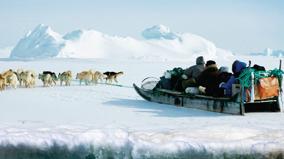Katinngat
Ilaqutariit Inughuit qimussimik ingerlaarput Kalaallit Nunaanni sikumi isorartoorsuarmi. Ingerlaarfissualli aakkiartorpoq, qimmillu siku aserortertoq nakkarfigisarpaat, nakkarfigisarlugu Issittumi imartaq nilleqisoq. Angalaqatigiinni utoqqartap Navaranap, akueriartuaalerpaa Issittumi inuiaat tamarmik allanngoriartornermik siornatigut aqqusaarsimanngisaannakkaminnik aqqusaarneqalersut. 1860-ikkunni Navaranap siulersua takorluuillaqqissorsuaq – angakkorsuaq Canadami Baffin Island-imeersoq, Qitdlarssuarmik atilik – angalanermut tusaamaneqaqisumut ilaavoq, naggueqatigiit Inuit Kalaallit Nunaannut ingerlaarnerannik kinguneqartumik. Tassa taassuma angakkorsuup nunassaminik ujaasinerata aakkut naggueqatigiinnerit uummaarissut, sakkunillu atortunillu ineriartortitsinerit, Navaranap siulianut nunassarsiortunut katinngaserpai. Ukiut 150-it sinnerlugit qaangiummata Navarana siulersuarmi nunaanut angalavoq, attaveqarfiginiarlugit Canadamiittut ungasissukkut illooraqqiutini. Navaranapangalaqatigaiilaqutariitnunanisumiiffinnimarlunniassigiinngitsuneersut, ukiumoortumik piniariarlutik angalaneranni. Isiginnaarpai qanoq taakkua aatsigut naggueqatigiit Inuit, allanngorarnernut avataaneersunit sunniutaasunut, piniarnermilu ileqqutoqqanut sunniuteqartunut qimarratigisinnaanngisaminnut, assigiinngunik periuseqarlutik imminnut tulluarsartarsimanerat. Misilittakkani aallaavigalugit …

Angalaqatigiinni utoqqartap Navaranap, akueriartuaalerpaa Issittumi inuiaat tamarmik allanngoriartornermik siornatigut aqqusaarsimanngisaannakkaminnik aqqusaarneqalersut. 1860-ikkunni Navaranap siulersua takorluuillaqqissorsuaq – angakkorsuaq Canadami Baffin Island-imeersoq, Qitdlarssuarmik atilik – angalanermut tusaamaneqaqisumut ilaavoq, naggueqatigiit Inuit Kalaallit Nunaannut ingerlaarnerannik kinguneqartumik. Tassa taassuma angakkorsuup nunassaminik ujaasinerata aakkut naggueqatigiinnerit uummaarissut, sakkunillu atortunillu ineriartortitsinerit, Navaranap siulianut nunassarsiortunut katinngaserpai. Ukiut 150-it sinnerlugit qaangiummata Navarana siulersuarmi nunaanut angalavoq, attaveqarfiginiarlugit Canadamiittut ungasissukkut illooraqqiutini.
Navaranapangalaqatigaiilaqutariitnunanisumiiffinnimarlunniassigiinngitsuneersut, ukiumoortumik piniariarlutik angalaneranni. Isiginnaarpai qanoq taakkua aatsigut naggueqatigiit Inuit, allanngorarnernut avataaneersunit sunniutaasunut, piniarnermilu ileqqutoqqanut sunniuteqartunut qimarratigisinnaanngisaminnut, assigiinngunik periuseqarlutik imminnut tulluarsartarsimanerat. Misilittakkani aallaavigalugit neriuuteqarpoq inuiaqatimi ataannarnissaanut matuersaat toqqagassanut eqqortunut ammaassisinnaasoq nassaarisinnaassallugu.
Navarana eqqarsaatersortinneqarpoq neriuuteqalersinneqarlunilu inuiaqatigiit taakkua suli imminnut ataqatigiinneraniit, minnerunngitsumillu siulersuarmi ersigisaqaratik angalasarsimasunit kingornussassaanit, ukiuni issittumi inuusut inuiaat oqaluttuarisaanerminni inuiaqatigiittut avatangiisitigullu aatsaat taama unammillerneqarnerisa nalaanni.


















